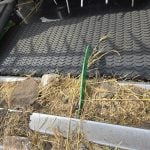Researchers are working to fine tune genes responsible for flinging 20 percent of canola on the ground
Ever since humans started farming, they have been fighting against crop plants’ tendency to spread their seed far and wide, said Lars Ostergaard a plant geneticist from the John Innes in the Norwich, England, at the Canola Week online conference on Dec. 1.
Ancestral cereals, like their near-wild grassy cousins, tended to toss their seeds to the ground either directly or by hitching a ride on an animal via beards, a trait familiar to anyone who has pulled foxtail barley seeds off their socks after walking through a pasture.
Likewise, plants with pods developed a system where, as the seeds ripen, the pods tighten until they rupture. This can fling the seeds considerable distance with great force, as anyone who has walked by a mature carragana hedge on a hot day can attest.
For the canola farmer, this is a problem.
“There are huge losses every year from this phenomenon called pod shatter,” Ostergaard said. “Pods are opening in the field and releasing the seeds. In the UK, the average loss per year is about 20 percent but it can increase to over 70 percent under severe conditions for instance if a hailstorm comes in just before harvest.”
Ostergaard is working to understand the genetics that control pod opening, using Arabadopsis thaliana, a relative of canola.
He and his team have identified genes that govern the molecular “glue” that holds the pods shut. The researchers have also found genes that dictate the formation of lignin in the pods. This tough, springy polymer is responsible for flinging the seeds far and wide when the pod bursts open.
By manipulating these genes, Ostergaard and his team are working to achieve a balance. Too much glue and the pods won’t open, making harvesting difficult. Too little, and the pods will release their seeds too easily.
Ostergaard said their hope is that by tweaking similar genes in canola, they can begin to develop varieties with uniform, optimum pod shattering characteristics. To this end, they are working with Polish canola (Brassica rapa) varieties with their eventual sights on Argentine varieties (B. napus).
Ostergaard and his team also looked at environmental factors, borne of field observations from British farms. Fields of winter canola have experienced much higher than normal winter temperatures, leading the crop to flower far too early, dramatically reducing yield. This led them on a broader quest to understand “developmental transitions” in the crop, from flowering and setting seed, to maturation and particularly pod shattering.

Using greenhouses, they subjected canola (B. napus) to different temperature regimes: 5C or 15C at 12 weeks development and 18 C or 24 C at flowering.
As expected, the researchers found that higher temperatures increased shatter rates. But plants subjected to higher temperatures early in development stayed shatter-prone, even if the temperatures stayed cool for the rest of their development. It’s knowledge that might help farmers manage canola crops in the field while Ostergaard and his colleagues tease out the genetic basis of what they are seeing.
“Hopefully this will then lead to some long-term improvements in sustainable performance of Brassica crops.”















